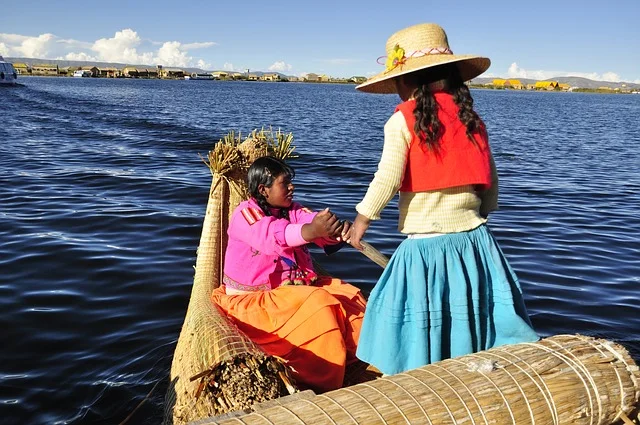The territorial border between Peru and Bolivia is Lake Titicaca. Its area is 8 thousand 300 sq. m. Each of the two countries owns half of a large reservoir. It is a salt lake located on a plain in the Andes.
There are about 30 islands on the reservoir territory; Moon Island and Sun Island are most popular among tourists. They are famous for their rich history, interesting sights, and picturesque landscapes.
Traditions of the population of the islands on Lake Titicaca
The shipping lake is considered the birthplace of the Inca tribe. Its islands are shrouded in secrets and legends. One of the most fantastic versions of the origin of the Incas sounds like this: they came to land directly from the water. It was these people who founded the city of Cuzco.
It is unknown who the craftsmen skillfully constructed buildings from giant stones without special equipment and cement. But we are talking about the progenitors of the indigenous inhabitants of the islands of Lake Titicaca. They are called the Uros people, as is the area itself. The local population preserves the traditions of their ancestors, passing them on from generation to generation.
No civilization, the absence of the benefits familiar to a modern person. Only cane huts and boats. The tribe uses this plant for food. People cultivate the land and eat what they grow in the garden beds. The main industries of the Uros Indians are hunting and fishing.
Interest in the islands’ inhabitants grows every year; therefore, tourism has become a new direction that generates income. The only way to get to the floating islands is by water. The reed boats, which outwardly resemble those that the ancient Egyptians once created, use the local population to move.
Features of living on the islands of the Sun and the Moon
The Quechua and Aymara Indians are the indigenous population of the Island of the Sun. During the existence of the Inca Empire, the island was used for religious rituals. This is evidenced by the flat stone that has survived to this day, called the Ritual Table. It was on it that ancient people brought sacrifices to the gods.
If sacrifices were performed on the island of the sun, then on the island of the moon, innocent girls were prepared for this. In those days, it was considered prestigious to be sacrificed. After all, the gods were given the best. Therefore, young beauties were sent to the island of the Moon 5 centuries ago. They lived there as nuns. They were called “daughters of the Sun.”
From an early age, girls were prepared to be sacrificed. They were completely cut off from the outside world and had no contact with other people. Only the High Inca had the right to come to the island of the moon and quietly observe the young ladies. So the ruler of a powerful tribe chose his wife. The fate of the rest of the beauties was a foregone conclusion: they were all sacrificed to the gods in turn.
Where, according to the ancient Incas, the moon and the sun appeared
The Incas believed that both the moon and the sun appeared from small depressions on the islands of Lake Titicaca. These places are called “Refuge of the Sun and Moon”. From this area, according to the history of the ancient people, first came the progenitors of the Incas – Manco Capac and Mama Ocllo. The dents on the Island of the Sun, visually resembling traces, can be considered a confirmation of this theory.
The indigenous people are convinced that these are traces of the sun. It is believed that daylight was born in this very place. It left its shelter and walked on the ground, leaving traces behind it. Such shrines of the Indians explain the origin of the name of the island – the sun.
Taquile Island on Lake Titicaca is famous for the ruins of prehistoric times
Another equally popular tourist attraction on the salt lake is Taquile Island. It contains the ruins of supposedly built buildings even before the area became part of the Inca empire. Archaeological excavations are not conducted here, so no one invests in their restoration. Because of this, the historical sites of Taquile Island are in poor condition: they are almost destroyed.
Lake Titicaca is considered a place of power. Therefore, those who are engaged in spiritual practices often come here. It is worth visiting for everyone looking for harmony in himself, who is confused or going through a difficult period in his life. Moving reed boats between the islands, admiring the local beauty, it is easy to feel like a part of the Universe. After such a journey into the past, there is a desire to live and enjoy every day.
Many places in Peru keep the memory of the Inca civilization. One of the most mysterious places in the city of Choquequirao, where the Indians were forced to flee from the attacks of the European conquerors. It was impossible to take this place by storm, but the fortress city could not protect the ancient people. The reasons for its disappearance are a mystery to scientists.
